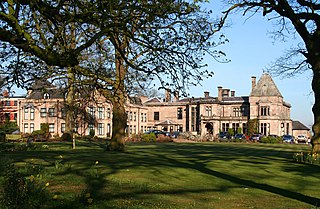
Ashton Court is a mansion house and estate to the west of Bristol in England. Although the estate lies mainly in North Somerset, it is owned by the City of Bristol. The mansion and stables are a Grade I listed building. Other structures on the estate are also listed.

Wraxall is a village in North Somerset, England, about 6 miles (10 km) west of Bristol. Until 1811 the parish of the same name also included Nailsea and Flax Bourton. The village is now within the parish of Wraxall and Failand.

Clevedon Court is a manor house on Court Hill in Clevedon, North Somerset, England, dating from the early 14th century. It is owned by the National Trust and is designated as a Grade I listed building.
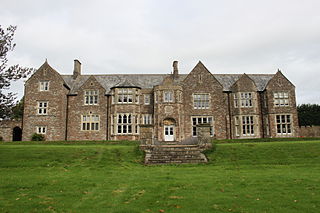
Sutton Court is an English house remodelled by Thomas Henry Wyatt in the 1850s from a manor house built in the 15th and 16th centuries around a 14th-century fortified pele tower and surrounding buildings. The house has been designated as Grade II* listed building.
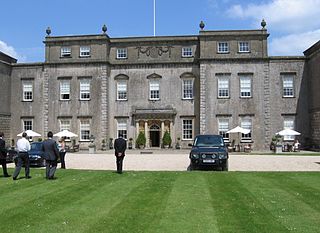
Ston Easton Park is an English country house built in the 18th century. It lies near the village of Ston Easton, Somerset. It is a Grade I listed building and the grounds are listed Grade II on the Register of Historic Parks and Gardens.

Chavenage House, Beverston, Gloucestershire is a country house dating from the late 16th century. The house was built in 1576 and is constructed of Cotswold stone, with a Cotswold stone tiled roof. David Verey and Alan Brooks, in their Gloucestershire Pevsner, describe the house as "the ideal sixteenth-century Cotswold stone manor house". Chavenage is a Grade I listed building.
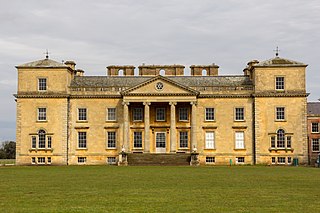
Croome Court is a mid-18th-century Neo-Palladian mansion surrounded by extensive landscaped parkland at Croome D'Abitot, near Upton-upon-Severn in south Worcestershire, England. The mansion and park were designed by Lancelot "Capability" Brown for the 6th Earl of Coventry, and they were Brown's first landscape design and first major architectural project. Some of the mansion's rooms were designed by Robert Adam. St Mary Magdalene's Church, Croome D'Abitot that sits within the grounds of the park is now owned and cared for by the Churches Conservation Trust.

The Red Lodge Museum is a historic house museum in Bristol, England. The original building was Tudor/Elizabethan, and construction began in 1579–1580, possibly to the design of Sebastiano Serlio. The main additional building phases are from the 1730s and the early 19th century.

Lytes Cary is a manor house with associated chapel and gardens near Charlton Mackrell and Somerton in Somerset, England. The property, owned by the National Trust, has parts dating to the 14th century, with other sections dating to the 15th, 16th, 18th, and 20th centuries. "Yet all parts blend to perfection with one another and with the gentle sunny landscape that surrounds them," comments Nikolaus Pevsner. The House is listed as Grade I by English Heritage.

Cornwell is a small village and civil parish about 2.5 miles (4 km) west of Chipping Norton in the West Oxfordshire district of Oxfordshire, near the county border with Gloucestershire. The 2001 Census recorded the parish's population as 66.

Wormleighton Manor is a manor house in the civil parish of Wormleighton in the historic county of Warwickshire, England. It belonged to the wealthy Spencer family during the 16th and 17th century. Much of the house was burned down by Royalists during the English Civil War in 1645 and abandoned by the Spencers in favour of Althorp in Northamptonshire, which contains some materials salvaged from Wormleighton to this day. Today, all that is left of the manor, which was once four times the size of Althorp, is the Wormleighton Manor Gatehouse and Tower Cottage which is a Grade II listed building, and the northern range of the manor.

Over Langford Manor, also known as The Old Courthouse is a Grade II listed building, in Upper Langford, North Somerset, England.

The Saltford Manor is a stone house in Saltford, Somerset, near Bath, that is thought to be the oldest continuously occupied private house in England, and has been designated as a Grade II* listed building.

Boughton Monchelsea Place, previously Boughton Court, is a 16th-century country house in Boughton Monchelsea, Kent, England. The first part of the house was built by Robert Rudston circa 1567–75 on the site of an earlier manor house. It has been modified a number of times during its history achieving its present form in 1819. It has been a home to a number of members of parliament for Maidstone or for Kent, including Sir Francis Barnham, Sir Robert Barnham (1646–85) Sir Barnham Rider (1698–1728) and Thomas Rider (1805–47).

Sir Richard Percivale of Sydenham, near Bridgwater, Somerset, was an English administrator and politician, also known as a Hispanist and lexicographer. He wrote a Spanish grammar for English readers, A Spanish Grammar, and a dictionary, both included in his Bibliotheca Hispanica (1591); this work was later enlarged by John Minsheu in A dictionarie in Spanish and English.
The Manor House in Chew Magna, Somerset, England, was a country house built in the middle of the 17th century. It was the principal residence of the Adlam family from the mid-1800s until 1940. The house is a Grade II* listed building and formed part of the Sacred Heart Convent School. It has now been redeveloped and returned to residential use.
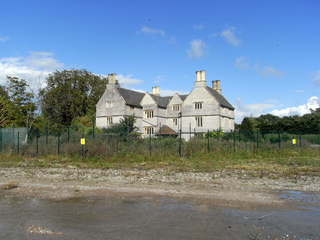
Sydenham House, the manor house of the ancient manor of Sydenham in the parish of Wembdon, Somerset, England, is a grade II listed building, constructed in the early 16th century and refronted and rebuilt after 1613. In 1937, British Cellophane Ltd set up production and built extensive factories on 59 acres (24 ha) of land adjacent to the manor house. Production ceased in 2005 and between 2010 and 2015 the industrial site was razed to the ground. In 2015 the razed site is owned by EDF Energy, which in 2012 purchased the manor house with the former factory site, intended for construction of temporary accommodation for 1,000 workers.
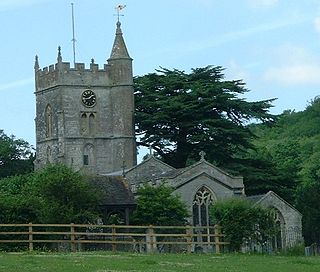
The Anglican Church of St Mary in Compton Dando within the English county of Somerset dates from the 14th century. It is a Grade II* listed building.
Urchinwood Manor is a Grade II* listed building at Congresbury within the English county of Somerset.












